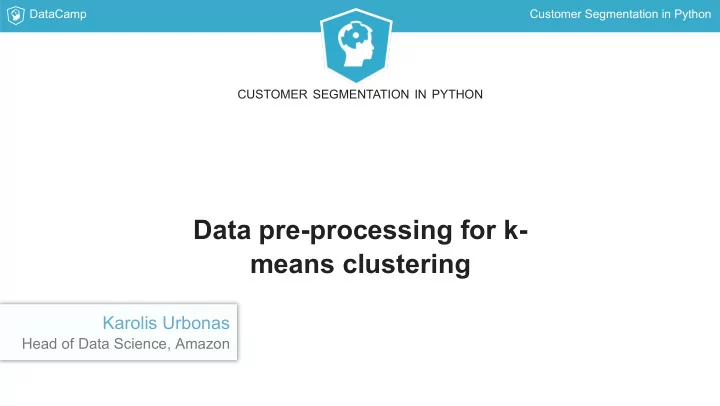

DataCamp Customer Segmentation in Python CUSTOMER SEGMENTATION IN PYTHON Data pre-processing for k- means clustering Karolis Urbonas Head of Data Science, Amazon
DataCamp Customer Segmentation in Python Advantages of k-means clustering One of the most popular unsupervised learning method Simple and fast Works well* * with certain assumptions about the data
DataCamp Customer Segmentation in Python Key k-means assumptions Symmetric distribution of variables (not skewed) Variables with same average values Variables with same variance
DataCamp Customer Segmentation in Python Skewed variables Left-skewed Right-skewed
DataCamp Customer Segmentation in Python Skewed variables Skew removed with logarithmic transformation
DataCamp Customer Segmentation in Python Variables on the same scale datamart_rfm.describe() K-means assumes equal mean And equal variance It's not the case with RFM data
DataCamp Customer Segmentation in Python CUSTOMER SEGMENTATION IN PYTHON Let's review the concepts
DataCamp Customer Segmentation in Python CUSTOMER SEGMENTATION IN PYTHON Managing skewed variables Karolis Urbonas Head of Data Science, Amazon
DataCamp Customer Segmentation in Python Identifying skewness Visual analysis of the distribution If it has a tail - it's skewed
DataCamp Customer Segmentation in Python Exploring distribution of Recency import seaborn as sns from matplotlib import pyplot as plt sns.distplot(datamart['Recency']) plt.show()
DataCamp Customer Segmentation in Python Exploring distribution of Frequency sns.distplot(datamart['Frequency']) plt.show()
DataCamp Customer Segmentation in Python Data transformations to manage skewness Logarithmic transformation (positive values only) import numpy as np frequency_log= np.log(datamart['Frequency']) sns.distplot(frequency_log) plt.show()
DataCamp Customer Segmentation in Python Dealing with negative values Adding a constant before log transformation Cube root transformation
DataCamp Customer Segmentation in Python CUSTOMER SEGMENTATION IN PYTHON Let's practice how to identify and manage skewed variables!
DataCamp Customer Segmentation in Python CUSTOMER SEGMENTATION IN PYTHON Centering and scaling variables Karolis Urbonas Head of Data Science, Amazon
DataCamp Customer Segmentation in Python Identifying an issue datamart_rfm.describe() Analyze key statistics of the dataset Compare mean and standard deviation
DataCamp Customer Segmentation in Python Centering variables with different means K-means works well on variables with the same mean Centering variables is done by subtracting average value from each observation datamart_centered = datamart_rfm - datamart_rfm.mean() datamart_centered.describe().round(2)
DataCamp Customer Segmentation in Python Scaling variables with different variance K-means works better on variables with the same variance / standard deviation Scaling variables is done by dividing them by standard deviation of each datamart_scaled = datamart_rfm / datamart_rfm.std() datamart_scaled.describe().round(2)
DataCamp Customer Segmentation in Python Combining centering and scaling Subtract mean and divide by standard deviation manually Or use a scaler from scikit-learn library (returns numpy.ndarray object) from sklearn.preprocessing import StandardScaler scaler = StandardScaler() scaler.fit(datamart_rfm) datamart_normalized = scaler.transform(datamart_rfm) print('mean: ', datamart_normalized.mean(axis=0).round(2)) print('std: ', datamart_normalized.std(axis=0).round(2)) mean: [-0. -0. 0.] std: [1. 1. 1.]
DataCamp Customer Segmentation in Python CUSTOMER SEGMENTATION IN PYTHON Test different approaches by yourself!
DataCamp Customer Segmentation in Python CUSTOMER SEGMENTATION IN PYTHON Sequence of structuring pre-processing steps Karolis Urbonas Head of Data Science, Amazon
DataCamp Customer Segmentation in Python Why the sequence matters? Log transformation only works with positive data Normalization forces data to have negative values and log will not work
DataCamp Customer Segmentation in Python Sequence 1. Unskew the data - log transformation 2. Standardize to the same average values 3. Scale to the same standard deviation 4. Store as a separate array to be used for clustering
DataCamp Customer Segmentation in Python Coding the sequence Unskew the data with log transformation import numpy as np datamart_log = np.log(datamart_rfm) Normalize the variables with StandardScaler from sklearn.preprocessing import StandardScaler scaler = StandardScaler() scaler.fit(datamart_log) Store it separately for clustering datamart_normalized = scaler.transform(datamart_log)
DataCamp Customer Segmentation in Python CUSTOMER SEGMENTATION IN PYTHON Practice on RFM data!
Recommend
More recommend